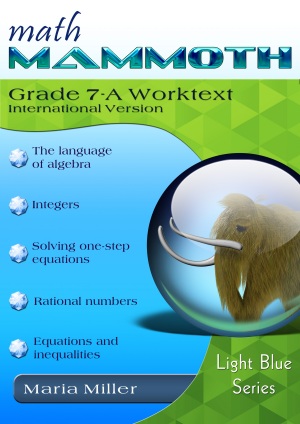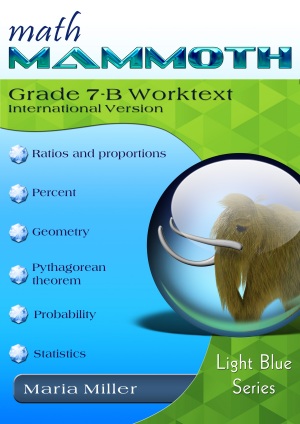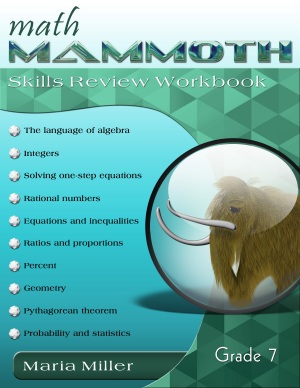Math Mammoth Grade 7 International Version
Math Mammoth Grade 7 International Version is a complete maths program for seventh grade, available both as digital and print versions.

228 pages
202 lesson pages

288 pages
253 lesson pages
Grade 7 contents and samples
Scope and sequence
Worksheet generator preview
User Guide, grade 7
Prices & ordering
Downloads:
Grade 7 full set: USD $42.50
(the two worktexts, answer keys, tests, cumulative revisions, worksheet maker, and Soft-Pak)
Part 7-A only: USD $21.25
(Everything for the first half of 7th grade math, incl. Soft-Pak)
Part 7-B only: USD $21.25
(Everything for the first half of 7th grade math, incl. Soft-Pak)
You will be purchasing the downloads from my authorized reseller Comecero.
Printed copies
The links below are for the Lulu bookstore.
7-A worktext
7-B worktext
Tests & Mixed Revisions
Answer Keys
Skills Review Workbook

This workbook is supplemental, and provides additional practice for the topics in the curriculum. I recommend you only purchase it once you are sure the student does need supplemental practice. Learn more.
At the heart of the curriculum are two student worktexts (A and B), each covering about half a year of maths work. These worktexts contain all the instruction and the exercises in the same book — which makes lesson preparation a breeze. The worktexts are written directly to the student, and thus they allow many children (if they can read) to teach themselves and to learn directly from the books.
You will also get separate answer keys, chapter tests, additional cumulative revisions (I do recommend you use at least some of them), and a versatile worksheet maker (Internet access required) for those times when your child needs just a bit more practice.
This curriculum is essentially the same as the US version of Math Mammoth Grade 7, only customised for the international audience in these aspects:
- The curriculum teaches the metric measurement units. Imperial units, such as inches and pounds, are not used.
- The spelling conforms to British international standards (British English).
- Page (paper) size is A4.
- Large numbers are formatted with a space as the thousands separator (such as 12 394). (The decimals are formatted with a decimal point, as is used in the US version.)
In money-related word problems, the symbol used is "$" (dollar).
The US version of the curriculum is aligned to the Common Core Standards, which means this curriculum may not be properly aligned to the seventh grade standards in your country. However, you can probably find material for any missing topics in neighbouring grades, which means you can simply re-order the material to solve most incompatibilities between different standards.
Features
- Math Mammoth focuses on conceptual understanding. It explains the "WHY", so your children can understand the maths, not just learn "HOW" to do it.
- Concepts are often explained with visual models, followed by exercises using those models. These visual models can take the place of manipulatives for many children; however, it is very easy to add corresponding manipulatives to the lessons if so desired.
- The curriculum is mastery-oriented. This means it concentrates fairly long on a topic, delving into its various aspects. This promotes conceptual understanding, as opposed to spiral curricula that often tend to jump from topic to topic too much.
- There is a strong emphasis on mental maths and number sense.
- It requires very little teacher preparation, which is a big help to most parents.

- The curriculum has no separate teacher's manual nor is it scripted. The introduction to each chapter has some notes for the teacher concerning the material in the chapter. All the instruction is written directly to the student in the worktext, and there also exist accompanying videos where you can see Maria herself teach the material.
- After each chapter introduction, you will find a list of Internet links and resources (games, quizzes, animations, etc.) that can be used for fun, illustrations and further practice.
Additional features for the download version
- The PDF files can be filled in on a computer, phone or tablet, using the annotation tools found in many PDF apps. Learn more.
- BONUS! The download version also comes with BONUS Soft-Pak programs. The 6 programs in Soft-Pak (4 math, 1 language arts, 1 list maker) offer both on-screen and printable activities in a low-graphic, high content format. Read more and see screenshots.
Overview of topics
In the book 7-A, we start out with an introduction to basic algebra, which is in many ways a revision of the same topics from 6th grade. The first chapter revises the order of operations, the concepts of an expression and equation, and the distributive property. Students learn about the commutative and associative properties of addition and multiplication, and they simplify expressions that do not involve negative numbers.
In chapter 2, we study integers (signed numbers) and their operations in detail. Some of this is revision from 6th grade, and some of it is new. The four operations of integers are explained with the help of two visual models: the number line and counters, hopefully providing an intuitive understanding of the processes. Students need to be able to add, subtract, multiply, and divide integers when they learn to solve equations in chapter 3. In the end of the chapter students also learn about negative fractions.
In the next chapter (chapter 3) students study simple one-step equations. They already know the basics of how to solve this type of equations from 6th grade, but this time we use negative numbers in them.
Chapter 4 is titled Rational Numbers, which are simply fractions and certain decimals, so the student is already very familiar with them. The goal of the chapter is to be able to add, subtract, multiply and divide both positive and negative fractions and decimals. We also solve simple equations involving fractions and decimals and learn about scientific notation.
The last chapter in part 7-A focuses on linear equations. The student learns to solve various types of linear equations and practises using those in simple word problems. We study linear inequalities but not to the same depth as linear equations. Lastly, the student graphs linear equations and is introduced to the concept of slope, which is the steepness of a line. The student can continue studying these topics with more details in an Algebra 1 course.
Part B starts out with a study of ratios and proportions (chapter 6). Students study unit rates, proportions, proportional relationships and graphing, scaling geometric figures, floor plans and maps.
The next chapter provides thorough lessons on the concept of percent. Students learn to solve a wide variety of problems involving percentages, including percentage of change, percentages of comparison, and simple interest problems.
Geometry is our focus in chapter 8. Students draw geometric figures using a a protractor and a ruler, and they also learn some basic geometric constructions. The other themes of this chapter are various angle relationships, area and the perimeter of a circle, conversions between units of area and of volume, surface area, volume and cross- sections when solids are sliced with a plane.
Chapter 9 covers square roots, the Pythagorean Theorem, and its applications. I have included the Pythagorean Theorem in order to make the curriculum work as a pre-algebra course, and you can omit the entire chapter 9 if you are following the Common Core Standards for grade 7.
Chapter 10 is an introduction to probability. Besides learning the basic idea behind probability as the ratio of favourable events to all possible events, students compare experimental probabilities to theoretical ones in probability simulations and even design some on their own.
Lastly, in chapter 11, the curriculum covers statistical concepts. The major areas of study are random sampling and learning to compare two populations using some basic statistical measures and graphs.
Please also see the table of contents for 7-A and 7-B (in the sample), which will let you see the topics covered in more detail.
Reviews / Testimonials of the 7th grade curriculum
Math Mammoth · Affordable Homeschool Curriculum for 7th Grade at Grace, Grow & Edify blog
Math Mammoth Light Blue Series Level 7: A TOS Review Crew Review at Grace-Filled Homeschooling blog
Review of Math Mammoth Prealgebra Curriculum by David Chandler from Math Without Borders.
I just covered 7th grade the distributive property.
YES!!!! I love the way you introduced this and the way the problems build to understanding. My students were excited about solving these problems. It was like a fun puzzle for them. This is a big gem!!!!
Beautiful.
deb b. :)
September 2015
Tara Dilan
June 2015
How and where to order
You can buy Math Mammoth International Version:
- As a digital version on this site (Mathmammoth.com) — using the "Add to cart" buttons.
- As a print version at Lulu and at other bookstores. You will find links to Lulu and the ISBN numbers at the product pages.
Also available:
Math Mammoth Grades 1-4 Bundle, International Version, $112.50 USD
Get grades 1-4 in a discounted bundle — 34% off! This means you save $57.50 USD.
Math Mammoth Grades 5-8 Bundle, International Version, $112.50 USD
Get grades 5-8 in a discounted bundle — 34% off! This means you save $57.50 USD.
By purchasing any of the books, permission IS granted for the purchaser (teacher or parent) to reproduce this material to be used with his/her students in a teaching situation; not for commercial resale. Please note: you are not permitted to share the material with other teachers or parents.
In other words, you are permitted to make copies for the students/children you are teaching, but not for other teachers' usage.
Receive my monthly collection of math tips & resources directly in your inbox — and get a FREE Math Mammoth book!
You can unsubscribe at any time.
Math Mammoth TourConfused about the different options? Take a virtual email tour around Math Mammoth! You'll receive: An initial email to download your GIFT of over 400 free worksheets and sample pages from my books. Six other "TOURSTOP" emails that explain the important things and commonly asked questions concerning Math Mammoth curriculum. (Find out the differences between all these different-colored series!)This way, you'll have time to digest the information over one or two weeks, plus an opportunity to ask me personally about the curriculum. A monthly collection of math teaching tips & Math Mammoth updates (unsubscribe any time) We respect your email privacy.
Note: You will FIRST get an email that asks you to confirm your email address. If you cannot find this confirmation email, please check your SPAM/JUNK folder. |
"Mini" Math Teaching CourseThis is a little "virtual" 2-week course, where you will receive emails on important topics on teaching math, including:
- How to help a student who is behind You will also receive: A GIFT of over 400 free worksheets and sample pages from my books right in the very beginning.We respect your email privacy.
Note: You will FIRST get an email that asks you to confirm your email address. If you cannot find this confirmation email, please check your SPAM/JUNK folder. |
Maria's Math TipsEnter your email to receive math teaching tips, resources, Math Mammoth news & sales, humor, and more! I tend to send out these tips about once monthly, near the beginning of the month, but occasionally you may hear from me twice per month (and sometimes less often). Peek at the previous tips here. You will also receive:
We respect your email privacy.
|
|
